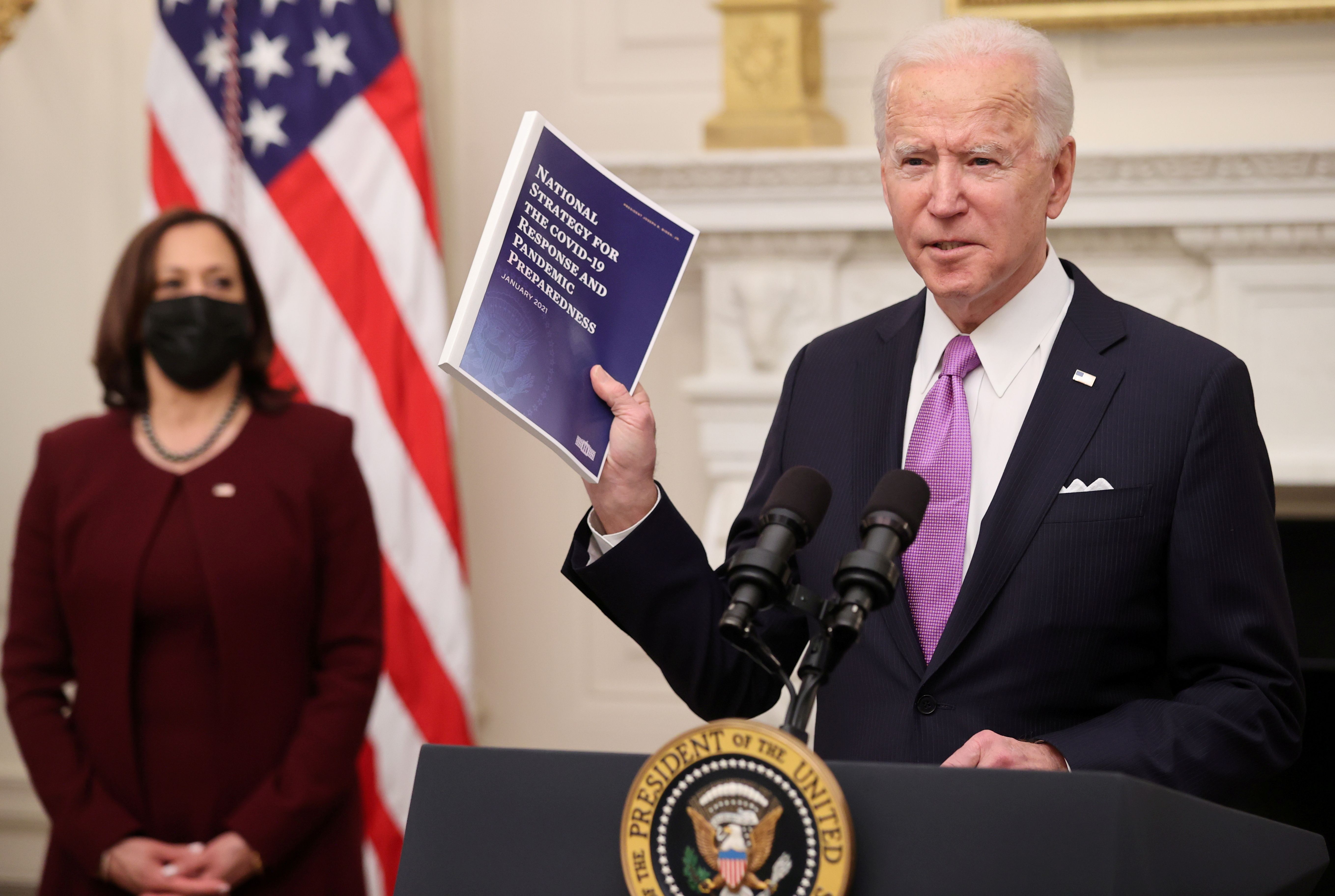Biden’s Most Urgent Task: Fighting the Pandemic

Second Wave
The COVID-19 pandemic in the U.S. is still raging. Since the beginning of December, the daily number of new cases of SARS-CoV-2 infections has frequently exceeded 200,000, sometimes even approaching 300,000. The daily number of deaths has ranged from about 2,000 to more than 4,000. In total, nearly 24 million infections have been detected in the U.S. so far and more than 400,000 people have died from COVID-19 (in both cases, these are the highest rates in the world). The economic situation is also deteriorating. Unemployment stood at 6.7% in December—the same as in November, which is the second time since April when, with the rate at 14.7%, it did not decrease compared to the previous month. There are 9.8 million more people unemployed in the U.S. today than in February 2020, before the pandemic was registered in the U.S., when the unemployment rate was 3.5%. After the first stimulus package expired in August last year, Congress and the Trump administration could not agree on further support for the economy. It was only in December that Congress adopted a second package worth $900 billion in total. It included a one-time $600 payment to people with incomes under $75,000 a year, a temporary increase in the unemployment benefit of $300 and another series of loans for small businesses.
Vaccination Programme
In May 2020, the U.S. began a public-private partnership to facilitate and diversify vaccine research, and then to coordinate its production and distribution process. Dubbed Operation Warp Speed and launched with funding from the first stimulus package of March 2020, the programme includes the Department of Health and Human Services, the Centers for Disease Control and Prevention, the Food and Drug Administration (FDA), as well as the Department of Defense and private companies. Its goal was to supply the U.S. with 300 million doses of a vaccine by early 2021. Under the programme, government funding for vaccine research was given to Moderna, Johnson & Johnson, AstraZeneca in cooperation with the University of Oxford and Vaccitech, Novanax, Merck and IAVI, and Sanofi and GlaxoSmithKline. The Moderna and Pfizer vaccines (the latter company did not use federal funds) were approved by the FDA for emergency use in December 2020. Other companies are still conducting research and testing. In total, the U.S. has already ordered more than a billion doses of vaccine, which will be supplied by AstraZeneca (300 million), Pfizer (200 million), Moderna (200 million), Novanax (110 million), Johnson & Johnson (100 million) and Sanofi (100 million). On 14 December, the vaccination programme began. To date, more than 12 million Americans have received at least one of the two doses of vaccine, and less than 2 million have received two doses, while the Trump administration’s goal was to fully vaccinate 20 million people by the end of 2020. It is estimated that to obtain so-called herd immunity in the U.S., it is necessary to vaccinate about 70% of citizens over 18 years of age, or almost 150 million people. For densely populated metropolitan areas such as New York, the ratio may need to be as high as 80%.
Biden Administration Strategy
The new president plans to change the vaccination strategy. It will seek to distribute all available vaccine doses (the Trump administration claimed to pursue a strategy which was to have enough on hold to ensure a second dose but the stockpile appears to have been exhausted). The new strategy (100 million vaccinations in the first 100 days) envisages the creation of federal vaccination points (currently they are run exclusively by state authorities) and the use of mobile units to reach smaller communities. Biden also plans to declare use of the Defense Production Act to outsource contracts to private companies to speed up vaccine production. The act was triggered by the Trump administration to supply hospitals with respirators. To fully open up the economy, Biden wants federal funding to enable testing of every employee in sectors that will be reopening. He also wants to provide personal protective equipment for employees, maintain salaries for COVID-19 patients, and create transparent rules for pandemic-related safety measures in workplaces. In addition, members of the Biden administration have experience tackling the Ebola outbreak in 2014 and administration approaches to public health threats, which might help coordinate efforts to combat COVID-19 more effectively.
In parallel with increasing efforts to contain the pandemic, the administration’s priority will be the next stimulus package adopted by Congress, now under the control of the Democratic Party. Biden announced two stages of action at the start of his term of office. The first is the next relief bill with a total cost of $1.9 trillion. It assumes the allocation of $1 trillion in direct aid—one-time $1,400 payments ($2,000 in total when combined with the earlier $600 from the second package), extending the duration of the higher unemployment benefit increasing it by an additional $100 until September, and introducing 14-weeks paid leave for people who are ill, in quarantine, or caring for people suffering from COVID-19. Biden wants to spend $400 billion on medical programmes (including testing, vaccinations, additional equipment for hospitals). At the same time, he wants to diversify aid measures, primarily targeting poorer communities, low-income small businesses and those most disadvantaged in the labour market, especially racial minorities. He wants to allocate $440 billion in aid to these groups.
The second stage of the plan assumes work on an act that includes an increase in tax relief for citizens and an increase in taxes for corporations (from 21% to 28%) and the introduction of a new 15% tax on corporations with annual revenues over $100 million (to balance the growing budget deficit), infrastructure investments and co-financing for companies creating “green jobs”.
In the international dimension of the fight against the pandemic, Biden has already issued an executive order revoking the decision to withdraw the U.S. from the WHO. In turn, Dr. Anthony Fauci, who was named a special presidential adviser to Biden on COVID-19 and appointed head of the American delegation to the WHO, announced that the U.S. would join the international vaccine initiative, COVAX, supported by the WHO. In addition, the president’s advisers have signalled that the pandemic is a national security issue, which will affect U.S. foreign policy. It is likely that, despite the lack of prior announcements in this regard, the U.S. will increase its involvement in the international fight against the pandemic.
Summary and Conclusions
The Democrats’ control of both chambers of Congress will make it easier for Biden to implement his strategy and carry out activities that require the involvement of the legislative branch (such as stimulus packages). However, Biden’s announcements regarding rapid distribution of vaccines were tempered by a warning from the FDA and a recommendation not to change the current strategy. Experts fear that the rapid distribution plan could jeopardise the timing of the second dose, which could reduce the effectiveness of the vaccine. Also, some state and local governments are having problems distributing vaccines efficiently, sometimes resulting in wasting doses. The problem could become worse with faster distribution. However, Biden is likely not to depart from this goal, hoping to provide more Americans with at least limited resistance to the virus more quickly. To do this, he will engage the Federal Emergency Management Agency (FEMA) and urge governors to send the National Guard (military units managed at the state level and funded from the federal budget) to set up thousands of federal vaccination points to facilitate the logistics of rapid vaccination of the
The actions and declarations on the first day of the presidency are a signal that the Biden administration is determined to conduct the global fight against the pandemic parallel to domestic actions. In the coming weeks, Biden may seek to coordinate activities with the EU or G20 countries to conduct coherent actions in the scope of introducing or lifting restrictions, including controlled and safe restoration of passenger traffic between countries. Over time, the U.S. may engage in “vaccine diplomacy”, providing doses from its own stockpiles to poorer countries and exchanging experience in mass vaccination.


